IJCRR - 10(20), october, 2018
Pages: 32-41
Date of Publication: 26-Oct-2018
Print Article
Download XML Download PDF
Diversity of the Family Leguminosae in Koch Bihar District, West Bengal
Author: Subhajit Bandyopadhyay
Category: Life Sciences
Abstract:Introduction: Legume - a fascinating group of flowering plants belongs to the family Leguminosae or Fabaceae is deserve special attention as they play vital role both in human welfare as well as in ecological aspect. The district of Koch Bihar of West Bengal state has no account about the diversity of leguminous plants and their utilization by the ethnic and local peoples which initiates to undertake the present work. Methods: Extensive field surveys in different parts of Koch Bihar in different seasons of five consecutive years were conducted to record the legumes of the district and their uses following the standard methods. Voucher specimens were processed and identified by using relevant literature and matching with herbarium specimens. Result and Discussion: It is evident from the present study that the legumes of Koch Bihar district are represented by 81 species under 36 genera with Desmodium as dominant genus having 9 species. Maximum number of species have been recorded in the subfamily Faboideae (47 species) followed by Caesalpinioideae(18 species) and Mimosoideae(16 species). Among the 81 species of legumes there are 29 species of herbs, 28 species of trees, 16species of shrubs and 8species of climbers. It is interesting to note that a good number of legumes are exotic in origin and American elements are more dominant among the alien species. During the field study utilization of legume by the major ethnic communities (viz. Kheria, Oraon, Rabha, Rajbanshi, and Santal) and the local inhabitants of the district have also been recorded. It reveals that 31 species under 24 genera which is about 38% of the legume flora of the district are used in various purposes and several species have more than one kind of use. Conclusions: Destruction of the habitat and the anthropogenic interferences are identified as the basic causes for the loss of diversity of legumes of the district. Similarly, acculturation is the reason for extinction of traditional knowledge regarding herbal therapy.
Keywords: Mimosoideae, Caesalpinioideae, Faboideae, Ethnic community, Traditional knowledge
Full Text:
INTRODUCTION
The family Leguminosae (Fabaceae) commonly known as legume or bean family is the third largest family among the flowering plants which is represented by 19,500 species under 770 genera1 and is cosmopolitan in distribution. Human society is benefited by this group of plants as they are not only the source of pulses, fodder, oil seeds, medicines, timber etc but they also increase soil fertility by fixing atmospheric Nitrogen. This family is traditionally divided into three sub-families namely Mimosoideae, Caesalpinioideae and Faboideae (=Papilionoideae). Hutchinson2 had recognized these three sub-families as independent families-Mimosaceae, Caesalpiniaceae and Fabaceae. This view was followed by Cronquist3, Dahlgren4 and others. But the present trend is to consider the above stated three sub-families under broadly circumscribed Leguminosae or Fabaceae. Morphological characters as well as rbcL sequence data support this view5. Takhtajan6, Thorne7 and APGIV8 also recognized the similar treatment. Recently the Legume Phylogeny Working Group9 based on plastid matK gene sequences subdivided Leguminosae into six subfamilies namely Caecalpinioideae (recircumscribed), Cercidoideae, Detarioideae, Dialioideae, Duparquetioideae and Papilionoideae.
Koch Bihar- a district of North eastern part of the state of West Bengal is floristically rich. Though a number of stray publications are existing regarding the flora of the Koch Bihar like Aditya and Ghosh10, Bandyopadhyay11, Bandyopadhyay and Mukherjee 12,13,14, Banerjee15 but none of them reflect the diversity of leguminous plants of the district. The present work is therefore, undertaken to record the species diversity of the legumes of Koch Bihar district of West Bengal. Not only that an endeavor has also been made to record the local uses of such leguminous plants by the local ethnic and rural peoples of the district which will be helpful to preserve the indigenous knowledge of the ethnic communities of the district.
The district of Koch Bihar is situated under Jalpaiguri division of the state of West Bengal in between 26o 32’46”to 25o57’57”N latitude and 89o 52’ 00”to 88o45’02” E longitude and covering an area of 3,386 sq Km. The district is surrounded by Alipurduar district of West Bengal in northern and most part of Western side. The Southern boundary of the district is very much indented and is formed by the Rangpur district of Bangladesh. The eastern boundary is formed by the Goalpara district of Assam. The entire district is intersected by six river systems, namely Tista system, Jaldhaka system, Torsha system, Kalzani system, Raidak system and Gadadhar system. The soil of Koch Bihar district is alluvial type of rather recent origin and is mainly sandy loam type. The climate of the district is characterized by high humid atmosphere and abundant rain with the temperature being seldom excessive. The district receives an average rainfall of 320.1cm. Rajbanshi is the major ethnic community which constitute about 40% population of the district. The other ethnic groups are Kheria, Oraon, Rabha and Santal. Most of them are village dwellers and depend on plant and plant products to maintain their life and livelihood.
MATERIALS AND METHODS
The present work is based on screening of herbarium specimens deposited at Central National Herbarium, Howrah and extensive survey conducted in different areas of Koch Bihar district in different seasons of five consecutive years. Plant specimens were collected from the field and preserved following the guidelines of Lawrence16 and Jain & Rao17. Local uses of the plants and vernacular names (if any) were procured from the ethnic medicine men and elderly knowledgeable persons of the villages through interview. The information was collected following Jain18, 19, 20 and Pal & Jain21 with some minor changes wherever required. Correct identity and updated nomenclature of the collected plant specimens were established with the help of published literature and also comparing with the authentic herbarium specimens of Central National Herbarium (CAL).
RESULTS
Species diversity in the three sub-families of Leguminosae viz Faboideae (=Papilionoideae). Caesalpinioideae and Mimosoideae are presented in table 1, 2 and 3 respectively. Updated nomenclature of each species along with vernacular name (if any), habit, flowering and fruiting periods and their distributional status have been provided in these tables. Uses of plants by the ethnic communities and rural peoples have also been provided in the column ethno botanical uses. The following abbreviations are used in the table:
rt.-root, tw.-twig, lf.-leaf, fl.-flower, fr.-fruit, sd.-seed, wd.-wood, pl.-plant, st. bk. - stem bark

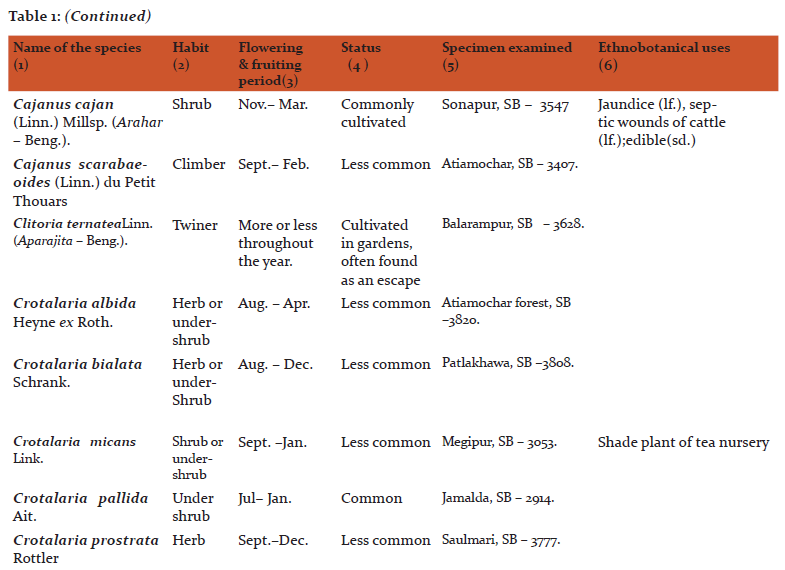
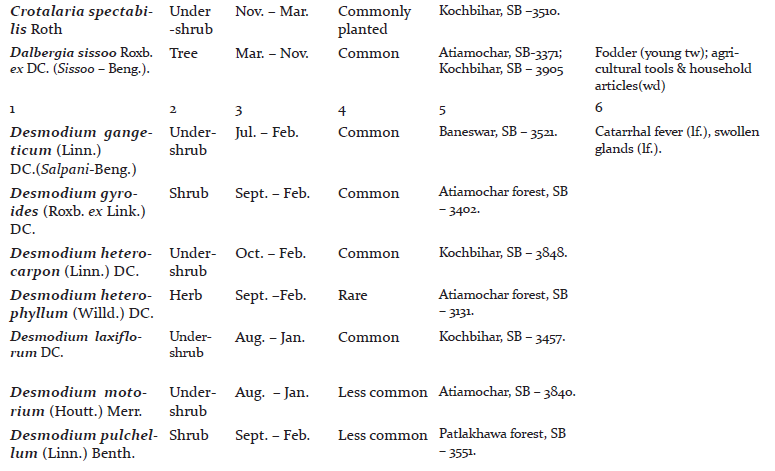


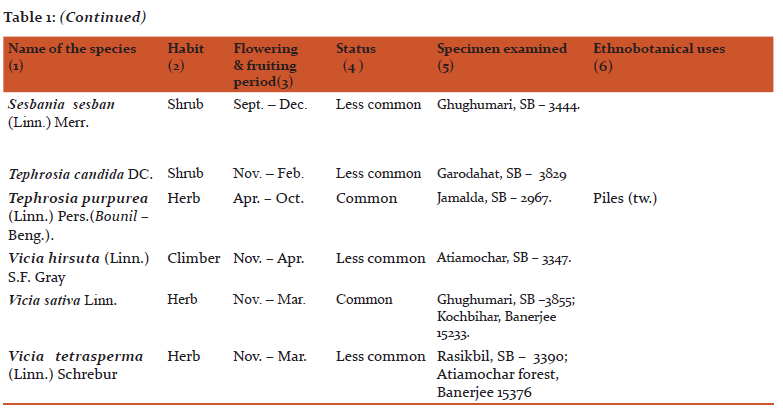
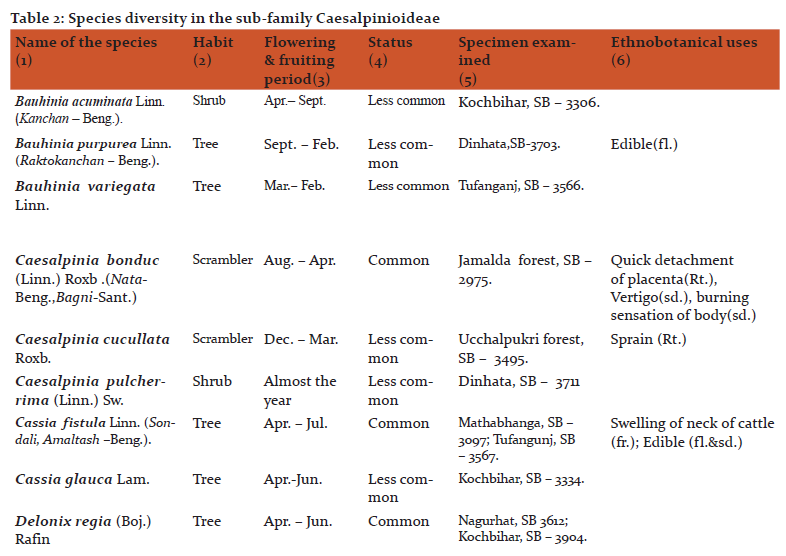
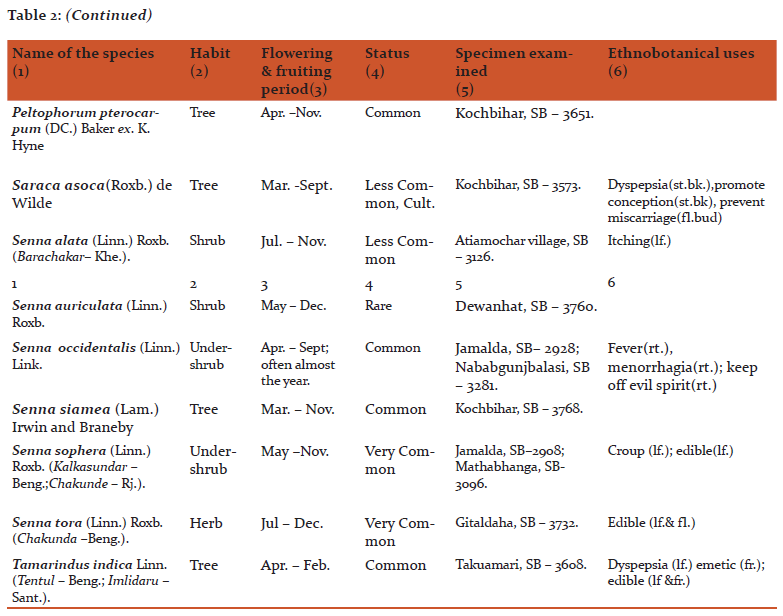

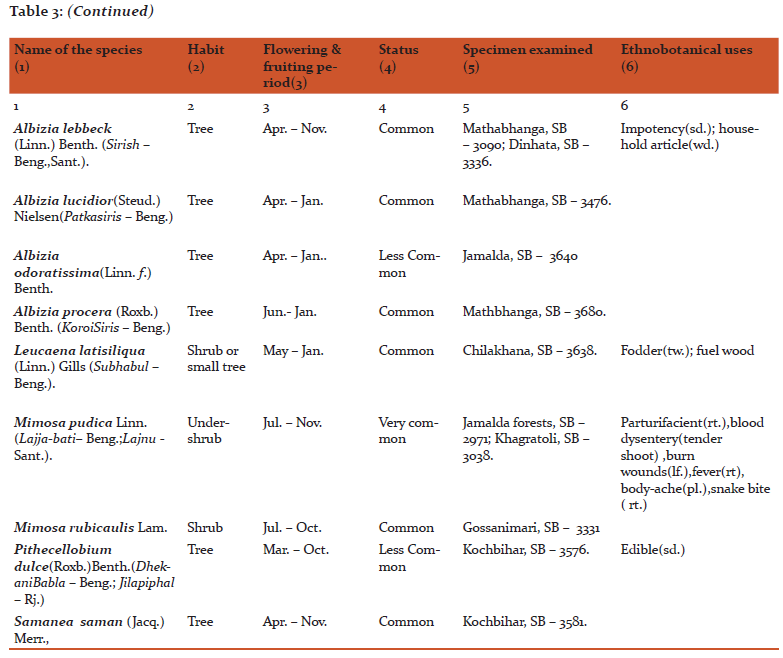
DISCUSSION
The forest vegetation of Koch Bihar district is Tropical moist deciduous type. Presently the district has a total forest cover of 45.31 sq. km and the forests are scattered in few pockets as protected forests. The common trees and shrubs of legumes in forest terrain includes Acacia catechu, Albizia chinensis, ,Butea monosperma, Dalbergia sisoo, Desmodium pulchellum, Erythrina stricta ,Flemingia macrophylla, Flemingia strobilifera etc. A number of herbaceous species of legumes are also grown in the forest floor. Some of them are Crotalaria albida, Crotalaria bialata, Desmodium motorium, Desmodium triquetrum, Mimosa pudica, Senna alata, Vicia hirsuta,Vicia tetrasperma etc. The common climbers and twiners found in this forest are Abrus precatorius, Caesalpinia bonduc, Caesalpinia cucullata, Cajanus scarabaeoides, Mucuna pruriens and Pueraria phaseoloides.
Beside the forest terrain, a vast stretches of land in the villages and urbanized area as well as wastelands beside agricultural fields, roadsides, railway tracks, canal banks, harbor a number of leguminous species. Tree legumes are generally planted by the villagers for meeting their needs or planted in afforestation programme by the forest department beside roads and waste places. It has been seen those tree species are sometimes naturalized and running wild. Some of them are Acacia auriculiformis, Acacia farnesiana, , Acacia nilotica subspecies cupressiformis, Albizia lebbeck, Albizia lucidior, Cassia fistula,, Dalbergia sisoo, Delonix regia, Derris indica,, Erythrina stricta, Erythrina variegata, Leucaena latisiliqua, Peltophorum pterocarpum, Pithecellobium dulce, Samanea saman, Senna siamea , Sesbania grandiflora, Tamarindus indica and others. The common herbs and undershrubs of those areas are Alysicarpus monilifer, Alysicarpus vaginalis, Crotalaria pallida, Desmodium gangeticum, Desmodium laxiflorum, Desmodium triflorum, Medicago lupulina, Mimosa pudica, Senna occidentalis, Senna sophera,Senna tora and many others.
It has been noted during study that a good number of species are exotic in origin and they became naturalized in Koch Bihar flora. American elements are more dominant among the exotic species, some of them are Acacia farnesiana, Caesalpinia pulcherrima, Clitoria ternatea , Delonix regia, Leucaena latisiliqua, Mimosa pudica, Pithecellobium dulce, Samanea saman, Senna alata, Senna occidentalis, Senna sophera, Senna tora and others. Similarly Lens culinaris, Lathyrus aphaca, Medicago lupulina, Melilotus alba, Vicia hirsuta, Vicia sativa etc constitute the European elements of the flora. Legumes of African origin naturalized in this district include Acacia nilotica, Lathyrus sativus, Sesbania sesban and Tamarindus indica.
The present study reveals that the legumes of the district of Koch Bihar are represented by 81 species under 36 genera. The proportions of genera to species are 1: 2.25. The numerical representation of genus and species under three subfamilies is presented in Table 4 and Diagram 1. A comparison between Koch Bihar, West Bengal22 and India23 regarding diversity of Legumes has been presented in Diagram 2. There are 28 species of trees, 16 species of shrubs, 29 species of herbs and 8 species of climbers recorded during study. The analysis of habits of the species in each sub-family is provided in Table 5 and Diagram 3. Among the legumes Desmodium shows maximum species diversity having 9species followed by Acacia, Crotalaria and Senna with 6 species each. In contrary there are 16 genera having single species each.
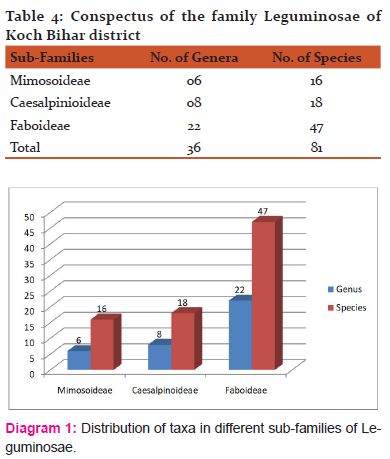

During the present study uses of leguminous plants by the ethnic communities and rural peoples of the district has also been recorded. The results shows that 31 species of legumes under 24 genera are used for various purposes which are about 38% of the legume flora of the district and several species have more than one kind of uses. The collected information shows that plants and plant parts of 11 species are edible, 20 species have medicinal uses, 2 species are used as fodder, woods of 3 species are used in constructions and making household articles and 6 species have miscellaneous uses. A total of 69 uses have been recorded during the present study and it has been noted that leaves of the legumes are used in maximum occasion (18) followed by stem & twigs (14) and roots & seeds (09).
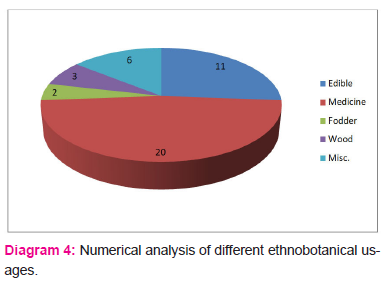
CONCLUSION
The present study concludes that the Leguminosae or Fabaceae is the most dominant and diversified family which constitutes about 10% of the total Angiospermic flora of the district. But the rapid urbanization and increase in population causes serious damage to the habitats of these plants. Much damage to the forest vegetation is being done by the cattle grazing. Grazing animals on one hand browse the tree seedlings and on the other hand trampling the soil and seedlings. Therefore, soil become compact and become unsuitable for the growth of the plants. Anthropogenic interference like extraction of “catechu” gum from Acacia catechu, peeling of barks for preparation of medicines and careless and illegal cutting and lopping from the plants for the purpose of fodder and firewood are the causes of the loss of species diversity. Similarly, extensive collection of useful seeds, fruits, roots etc. from plants like –Abrus precatorius, Derris indica, Butea monosperma, Mucuna pruriens etc. effects the natural regeneration of population of the species. On the other hand the indigenous knowledge especially the uses of the herbal drugs are in threat due to modernization of the society and loss of interest among the young generation of ethnic and rural peoples about the traditional healing methods. It is, therefore, an urgent need to protect the plants to save the diversity of leguminous flora as well as the ethnic culture of the district.
ACKNOWLEDGEMENT
The author is thankful to the Director and Late Dr. V. Mudgal, Additional Director, Botanical Survey of India for providing institutional facilities during the work. Thanks are also due to all forest officers and staffs, ethnic practitioners and other resource persons of Koch Bihar district without whose active co-operation the work could not be accomplished. Author is also grateful to his teachers Late Prof. A.K. Sarkar, Prof. G.G. Maity and Prof. S.K. Mukherjee (Retd.) Department of Botany, University of Kalyani for their valuable suggestions and encouragement during the work. Author acknowledges the immense help received from the scholars whose articles are cited and included in reference in the manuscript. The author is also grateful to authors/editors/publishers of all those articles, journals and books from where the literature for this article has been reviewed and discussed.
References:
-
The Legume Phylogeny Working Group. Legume phylogeny and classification in the 21st century: progress, prospects and lessons for other species rich clades. Taxon 2013; 62:217-48.
-
Hutchinson J. The Families of Flowering Plants. 3rd ed. London: Oxford University Press; 1973.
-
Cronquist A. Evolution and Classification of Flowering Plants. 2nded. New York: New York Botanic Garden; 1988.
-
Dahlgren G. The last Dahlgrenogram. Systems of classification of dicotyledons. In : Tan K. editor. The Davis and Hedge Festschrift. Edinburgh: Edinburgh University Press; 1989.p.249-60.
-
Doyle JA, Endress PK. Morphological phylogenetic analysis of basal angiosperms: comparison and combination with molecular data. Int Jour Plant Sci 2000; 165(6 suppl):S55-67.
-
Takhtajan A. Flowering Plants. 2nd ed.Springer;2009
-
Thorne RF. (2003). An updated classification of the class Angiospermae www.rsabg.org/publication/angiosp.htm.
-
The Angiosperm Phylogeny Group. An update of the Angiosperm Phylogeny Group classi?cation for the orders and families of ?owering plants: APG IV. Bot Jour Linn Soc 2016; 181: 1–20.
-
The Legume Phylogeny Working Group. A new subfamily classification of the Leguminosae based on a taxonomically comprehensive phylogeny. Taxon 2017; 64:44-77.
-
Aditya NR Ghosh RB. Further contribution to the flora of Cooch Behar district, West Bengal.Jour Econ Tax Bot 1989; 13: 437-53.
-
Bandyopadhyay S. A Systematic Census on the Sedges of Koch Bihar district, West Bengal. Ind Jour Appl Pure Biol 2017; 32:181-188.
-
Bandyopadhyay S, Mukherjee SK. Diversity of Aquatic & Wetland vascular plants of Koch Bihar district, West Bengal. In: Pandey AK et al., editors. Plant Taxonomy: Advances and Relevance. New Delhi: CBS Publishers; 2005.p.223-44.
-
Bandyopadhyay S, Mukherjee SK. Diversity of climbing plants in Koch Bihar district of West Bengal, India 2010; Pleione 4: 82-9.
-
Bandyopadhyay S, Mukherjee SK. A Sketch of the Monocot Flora of Koch Bihar district, West Bengal Jour Econ Tax Bot 2017; 40:99-103.
-
Banerjee BC. Addition to the flora of Cooch Behar district, West Bengal. Jour Econ Tax Bot 1992; 16 :177-83
-
Lawrence GHM. Taxonomy of vascular plants. London: Macmillan Company; 1951.
-
Jain SK Rao RR. A Handbook of Field & Herbarium Methods. New Delhi: Today and Tomorrows’ Printers and Publishers; 1977.
-
Jain SK. Medicinal Plant lore of tribal of Bastar. Econ Bot 1965; 19:236-50
-
Jain SK. editor. Glimpses of Indian Ethnobotany. New Delhi: Oxford and IBH Publishing Company; 1981.
-
Jain SK, A Manual of Ethnobotany, 2nd ed. Jodhpur: Scientific Publisher; 1995.
-
Pal DC, Jain SK. Tribal Medicine. Calcutta: Naya Prakash ; 1999.
-
Mitra S. Floristic diversity of West Bengal, India. Germany: Lambert Academic Publishing; 2016.
-
Karthikeyan S. 2000. A statistical analysis of flowering plants of India. In: Singh NP, Singh DK, Hajra PK, Sharma BD. editors. Flora of India Intro. Vol., Part II. Calcutta: Botanical survey of India; p. 201 – 17.
|






 This work is licensed under a Creative Commons Attribution-NonCommercial 4.0 International License
This work is licensed under a Creative Commons Attribution-NonCommercial 4.0 International License